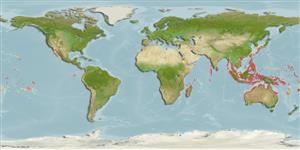Common names from other countries
Environment: milieu / climate zone / depth range / distribution range
Οικολογία
; εύρος βάθους 0 - 3 m (Ref. 100959). Tropical
Indo-Pacific: from East and South Africa, to eastern Polynesia; north to southern Japan, and south to southern Queensland and New Caledonia.
Length at first maturity / Μέγεθος / Βάρος / Age
Maturity: Lm ? range ? - ? cm Max length : 4.0 cm SHL αρσενικό/απροσδιόριστο; (Ref. 349); common length : 3.0 cm SHL αρσενικό/απροσδιόριστο; (Ref. 349)
Shell surface with radial ridges. Columella with 3 teeth. Colouration: pale with variable dark blotches, at times uniformly bluish black with pale interior (Ref. 128042).
Collected where common, for food and shellcraft, in many localities of the whole Indo-West Pacific (Ref. 349). In protected areas (Refs. 349, 128042). Common in intertidal rocks (Refs. 2925, 128042), often in crevices (Ref. 128042). Found in sandy shores, near the vicinity of the depression formed during low tides to avoid desiccation. Squirts water at its attacker when disturbed (Ref. 125338). Also found in mangrove areas (Ref. 129120).
Life cycle and mating behavior
Γεννητική Ωρίμανση | Αναπαραγωγή | Γεννοβολία | Αβγά | Γονιμότητα | Προνύμφες
Members of the order Neritopsina are mostly gonochoric and broadcast spawners. Life cycle: Embryos develop into planktonic trocophore larvae and later into juvenile veligers before becoming fully grown adults.
Poutiers, J.M. 1998. (Ref. 349)
IUCN Red List Status (Ref. 130435)
CITES status (Ref. 108899)
Not Evaluated
Not Evaluated
Threat to humans
Harmless
Human uses
| FishSource |
Εργαλεία
Διαδικτυακές πηγές
Estimates based on models
Preferred temperature
(Ref.
115969): 24.6 - 29.3, mean 28.5 (based on 2914 cells).
Vulnerability
Low vulnerability (10 of 100).
Price category
Unknown.
